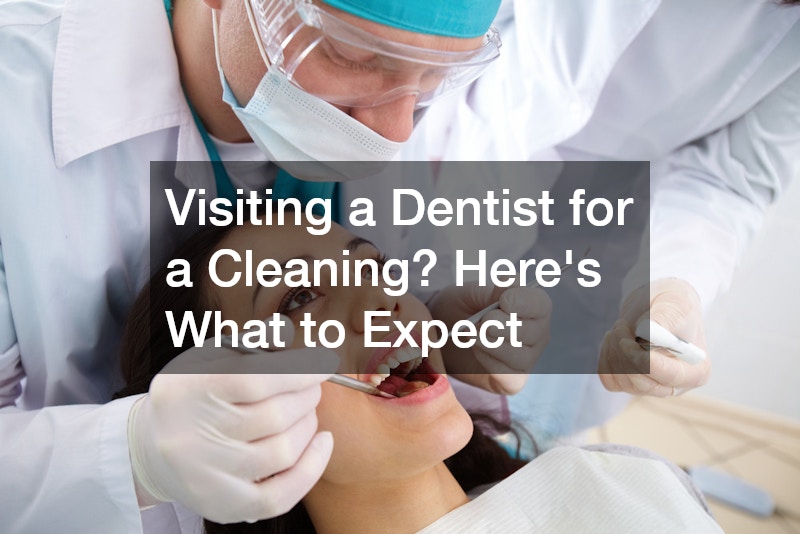Professional cleanings are about much more than just having your teeth polished. During a cleaning, your dentist can detect early signs of cavities, gum disease, oral infections, and even some systemic conditions that show symptoms in the mouth. Regular visits help prevent small issues from becoming painful or expensive problems later on.
Plaque and tartar (hardened plaque, also known as calculus) build up naturally on teeth over time. Plaque is a sticky film of bacteria that forms after eating or drinking.
If it isn’t removed with brushing and flossing, it can harden into tartar, which can only be removed by a dental professional. Left untreated, tartar buildup can lead to gingivitis, periodontitis, and eventually tooth loss.
In short, regular cleanings protect both your teeth and your overall health.
Step 1: The Dental Exam
Most cleanings begin with a quick examination by a dental hygienist. They’ll use a small mirror to look around your mouth and check for signs of gum inflammation, decay, or other potential problems.
If they spot something concerning—like deep pockets in your gums or a broken filling—they may consult with the dentist before proceeding. This preliminary exam ensures your cleaning is safe and appropriate for your current oral condition.
Step 2: Removing Plaque and Tartar (Scaling)
The next step is scaling, where the hygienist uses special tools to remove plaque and tartar from your teeth, especially along the gumline and between teeth. You’ll likely hear scraping sounds—this is completely normal.
Tartar can’t be removed by brushing or flossing, so this process is essential. If your gums are sensitive, you might feel slight discomfort or pressure, but it shouldn’t be painful. Let your hygienist know if you feel significant pain—they can adjust their technique or use a topical numbing gel if needed.
For patients with more severe buildup or early signs of gum disease, a deep cleaning (also called scaling and root planing) may be recommended. This more intensive procedure cleans beneath the gumline and is sometimes done over multiple appointments.
Step 3: Polishing
Once the tartar and plaque have been removed, the hygienist will polish your teeth using a high-powered electric brush and gritty toothpaste. The texture of this paste helps smooth the enamel and remove minor surface stains from coffee, tea, or food.
You’ll hear a gentle whirring sound during this part—it’s not a drill, just the polishing tool. Afterward, your teeth will feel smooth and clean to the touch.
Polishing isn’t only cosmetic; it also makes it harder for plaque to accumulate on freshly cleaned tooth surfaces.
Step 4: Flossing
Next, your hygienist will floss your teeth—often more thoroughly than you might at home. This step removes any remaining debris or plaque between teeth. It also helps the hygienist identify areas where your gums may bleed or where you might need to focus more attention when flossing daily.
Don’t worry if your gums bleed a little; this can happen if you have mild gingivitis or haven’t flossed regularly. Regular cleanings and daily flossing will help improve gum health over time.
Step 5: Rinsing and Fluoride Treatment (Optional)
After flossing, you’ll rinse your mouth to remove any leftover debris. Some dental offices offer a fluoride treatment as the final step. This can come as a gel, foam, or varnish applied to your teeth for a few minutes.
Fluoride strengthens tooth enamel, helping protect against cavities between cleanings. While it’s especially beneficial for children, many adults opt for fluoride treatments too—especially if they have a history of cavities or sensitivity.
Step 6: The Dentist’s Exam
In most dental practices, the dentist will perform a final check after your cleaning. They’ll review your chart, look at any X-rays taken during the visit, and perform an oral exam. This may include checking for:
-
Cavities or early signs of decay
-
Gum disease
-
Bite or alignment issues
-
Oral cancer (by examining the tongue, cheeks, and soft tissues)
If any issues are found, the dentist will discuss treatment options, such as fillings, fluoride rinses, or adjustments to your oral care routine.
Visiting your dentist for a cleaning is one of the simplest things you can do for your oral and overall health. The process is straightforward, comfortable, and preventive—helping you avoid more complicated treatments in the future.
If you haven’t had a cleaning in a while, don’t feel embarrassed or nervous. Dental professionals see patients at all stages of oral health and are there to help, not judge. With regular cleanings and good daily habits, you can enjoy a brighter smile and healthier gums for years to come.

